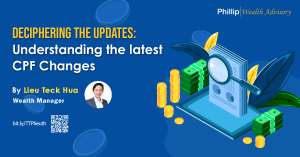Managing Trades and Investments: What’s the Difference? December 3, 2018

The Psyche of Traders and Investors
In the world of stocks and shares, it is important to recognise that rules for managing trades are different from that of managing investments. The Phillip Youth Stocks Challenge 2018 was a long-only trading competition over a three-week period. This provided opportunity for a suboptimal strategy given that the market has been undergoing a correction this year.
The psyche of a trader is unlike that of an investor. Traders usually hold positions over much shorter time frames, and correspondingly have clearly-defined entries and exits which are likely to differ from investors. In most cases, it does not make sense for investors to follow the calls of “trading gurus”. If you are an investor, ask yourself honestly, do you have a stop loss or exit strategy? Have you ever followed your stop loss policy and exited from a losing position? Knowing this, I offer three perspectives about managing personal investments, after taking part in the Youth Stocks Challenge.
Invest within Your Means
Do not use leverage if you cannot manage risk and refrain from borrowing. Many top-tier funds like Blackrock, Allianz and Manulife are down almost 30% year-to-date. If you started a fund in 2018, a 2x leverage would imply that the equity is 60% in the red, closing in on margin call territory. This stance was reversed for trading in the Challenge, where we were given $1,000,000 Buy and Sell limit daily. Not fully utilising this would be playing to lose.
Knowledge is Key
In this Challenge, you could get by with some awareness of market trading rules. In order to win the trading Challenge, I only traded stocks with the highest margin per tick (minimum unit change in stock price). In these short-term trades, the fundamentals of stocks are negligible as opposed to investing.
Knowledge allows you to make more rational and logical decisions. For example, investing in Temasek Bonds, with a 2.7% interest rate, may not be the appropriate option for all. Consider that interest rates are likely to challenge 5% within 5 years. Similar to how home buyers want to lock in fixed interest rates in a rising interest rate environment, an investor may seek floating rates of return.
Another example is structured products that banks offer to clients. Structured products offer the convenience of managing a position with various accompanying conditions. Some understanding of quantitative finance will allow you to deconstruct these products. You may recognise that by taking on a structured product, you would have lost the spread and margin to the bank. Additionally, the structure is such that the bank is hedged, and risk is passed to the client.
Paying for an investment course does not magically make you a better investor. Such courses typically organise and present factual information to you – information which you may otherwise found on your own by Googling. The question is whether you are willing to take that step to do so!
Treat Investments as Written Down
This may not apply to the short-term high-risk trading nature of the Challenge, but can be helpful for young investors. Invest only what you can afford to lose and treat all investments as sunk costs. You won’t lose sleep over your portfolio, and you will be happily collecting in a down market. If you do not have time to research on individual companies to invest in, try investing in an index. Warren Buffett’s successful bet that the index would outperform a basket of funds selected by an asset manager at Protégé Partners between 2007 and 2017 is testament to this.
You may not hit a home run by banking on a tech name like Apple, but who knows what other gains you may make?
Disclaimer
These commentaries are intended for general circulation. It does not have regard to the specific investment objectives, financial situation and particular needs of any person who may receive this document. Accordingly, no warranty whatsoever is given and no liability whatsoever is accepted for any loss arising whether directly or indirectly as a result of any person acting based on this information. Opinions expressed in these commentaries are subject to change without notice. Investments are subject to investment risks including the possible loss of the principal amount invested. The value of the units and the income from them may fall as well as rise. Past performance figures as well as any projection or forecast used in these commentaries are not necessarily indicative of future or likely performance. Phillip Securities Pte Ltd (PSPL), its directors, connected persons or employees may from time to time have an interest in the financial instruments mentioned in these commentaries. Investors may wish to seek advice from a financial adviser before investing. In the event that investors choose not to seek advice from a financial adviser, they should consider whether the investment is suitable for them.
The information contained in these commentaries has been obtained from public sources which PSPL has no reason to believe are unreliable and any analysis, forecasts, projections, expectations and opinions (collectively the “Research”) contained in these commentaries are based on such information and are expressions of belief only. PSPL has not verified this information and no representation or warranty, express or implied, is made that such information or Research is accurate, complete or verified or should be relied upon as such. Any such information or Research contained in these commentaries are subject to change, and PSPL shall not have any responsibility to maintain the information or Research made available or to supply any corrections, updates or releases in connection therewith. In no event will PSPL be liable for any special, indirect, incidental or consequential damages which may be incurred from the use of the information or Research made available, even if it has been advised of the possibility of such damages. The companies and their employees mentioned in these commentaries cannot be held liable for any errors, inaccuracies and/or omissions howsoever caused. Any opinion or advice herein is made on a general basis and is subject to change without notice. The information provided in these commentaries may contain optimistic statements regarding future events or future financial performance of countries, markets or companies. You must make your own financial assessment of the relevance, accuracy and adequacy of the information provided in these commentaries.
Views and any strategies described in these commentaries may not be suitable for all investors. Opinions expressed herein may differ from the opinions expressed by other units of PSPL or its connected persons and associates. Any reference to or discussion of investment products or commodities in these commentaries is purely for illustrative purposes only and must not be construed as a recommendation, an offer or solicitation for the subscription, purchase or sale of the investment products or commodities mentioned.
About the author
Jonathan Yang
Student, Singapore Management University
Winner of the Phillip Youth Stocks Challenge 2018
The writer of this article is winner of the Phillip Youth Stocks Challenge 2018, a contest held by PhillipCapital where youths engaged in a simulated stock-trading environment on the POEMS 2.0 platform. The views shared here reflect the winner’s perspective and do not necessarily represent the opinions of PhillipCapital and its members.

 Japan’s Economic Resurgence: Unveiling the Tailwinds Behind Nikkei 225’s Record Leap
Japan’s Economic Resurgence: Unveiling the Tailwinds Behind Nikkei 225’s Record Leap  How to soar higher with Positive Carry!
How to soar higher with Positive Carry! ![[Smart Park] Buy Insurance, Get Rich Quick? Not Exactly, But This Comes Close [Smart Park] Buy Insurance, Get Rich Quick? Not Exactly, But This Comes Close](https://www.poems.com.sg/wp-content/uploads/2024/03/Valerie-Lim-LI-X-SMART-Park-Article-300x157.jpg) [Smart Park] Buy Insurance, Get Rich Quick? Not Exactly, But This Comes Close
[Smart Park] Buy Insurance, Get Rich Quick? Not Exactly, But This Comes Close  Deciphering the Updates: Understanding the latest CPF Changes
Deciphering the Updates: Understanding the latest CPF Changes 









